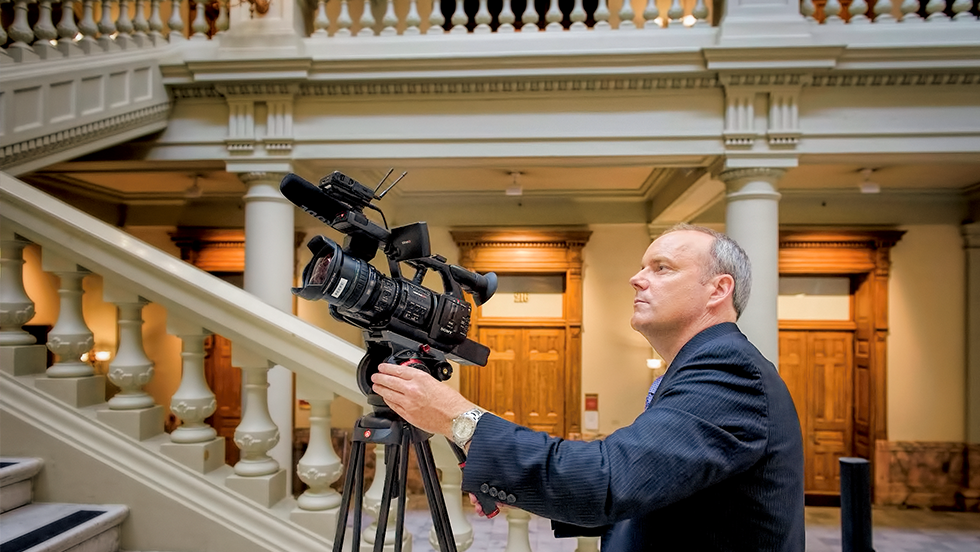Five Reasons To Care About Kenyon 2020
The College's strategic plan is more than a play on perfect vision. It's the future. And it starts now.
Read The StoryCity papers are dying and you can't always trust the Internet, but Kenyon journalists embrace the challenge of reporting the news with accuracy, perspective and expertise.
Story by Andrew Welsh-Huggins '83 P'17
COLUMBUS, Ohio — As a Kenyon freshman in the fall of 1979, I handwrote the first draft of my inaugural Collegian article about the fortunes of the cross country team, produced a second draft on my manual typewriter, then walked my four pages of deathless prose to the top of Peirce tower, where an editor mercifully cut it by two thirds. In those days, putting the paper together meant late nights on Wednesdays pasting columns of type onto layout pages, then several hours at a Mount Vernon print shop the next morning finishing the job.
Fast forward more than three decades. Supplementing my pen and notebook at the Associated Press in Columbus, Ohio, are tools unimaginable to my 17-year-old self: Twitter, Facebook, Skype and — mirabile dictu — a handheld device that records audio, video and still pictures, and even lets you call people. I’ve used text messaging to break news and people-finding apps to track down sources. I once employed a Blackberry to photograph the back of an Amish woman (with her permission) for a story that was shared around the world.
But what does all this mean, exactly? Story-telling technology has been evolving at least since Egyptians used hieroglyphics to report grain harvests. The telegraph, telephone, radio, TV, cable TV, Internet — all heralded changes in how news is collected and delivered. Is the newest development, the world of social media, any different? And if it is, what does it portend for the future of journalism?
I put these questions and others to 20 alumni journalists and a few Kenyon parents also in the field, including photographers and radio producers as well as TV, print and online reporters. Many worry about the industry. But I also heard something else, a point often reiterated: Quality is the key to survival.
“There’s a lot of difficulty figuring out exactly what the model is, but I keep coming back to one thing, which is always true,” said Matthew Winkler ’77 H’00 P’13, Bloomberg News editor-in-chief emeritus and a Kenyon trustee (pictured above). “People can’t make healthy decisions without reliable, accurate information.”
Or, as the youngest Kenyon journalist I interviewed put it: “People conflate the death of print journalism, which unfortunately I think is inevitable, with the death of journalism, which is not the case,” said Henri Gendreau ’16, the Collegian co-editor-in-chief.
Certainly, the golden era of newspapers is in the rearview mirror. Newspaper ad revenue, in a nose dive for several years, declined another 4 percent in 2014 to $19.9 billion, less than half what it was a decade earlier, according to the Pew Research Center’s 2015 State of the Media analysis. Daily and Sunday circulation was down 3 percent. Total newspaper revenue also continues to decline, although it should bottom out by 2017, providing some stability in the future, PricewaterhouseCoopers reported in its annual entertainment and media outlook.
Adding insult to injury, perceptions of reporting have sunk to levels that make lawyer jokes seem kind."
Papers are thinner than ever and in some cases less frequent — the Plain Dealer in Cleveland now delivers to homes just three times a week. Meanwhile, the family-owned paper is going the way of the family farm: In the midst of my writing this article, my hometown’s daily paper, the Columbus Dispatch, announced its purchase by New Media Investment Group Inc., ending 110 years of local ownership and foreshadowing at least some newsroom downsizing. Publisher John F. Wolfe’s open letter to the community summed up the dilemma: “Single-city, independent, family-owned newspapers — long the traditional model of American journalism — found they lack the economies of scale necessary to adapt in our fast-changing, digitally dominant information marketplace.”




As revenues decline, newsrooms are also shrinking, turning what used to be energetic expanses of ringing phones and buzzing conversation into what sometimes feel like mausoleums. The American Society of News Editors’ annual census found about 36,700 full-time daily newspaper journalists at nearly 1,400 newspapers in the United States last year, or 1,300 fewer than in 2012. “I certainly miss the old days,” said Dan DeWitt ’81, a reporter and columnist for the Tampa Bay Times, reflecting on the cavernous space he occupies in his Hernando County bureau with one other reporter following years of downsizing. Things are a little better on the local TV news side, where viewership was up slightly last year and ad revenue is healthy, thanks in large part to political advertising. But staffing is also down and salaries stagnant.
Adding insult to injury, perceptions of journalists have sunk to levels that make lawyer jokes seem kind. CareerCast’s annual rankings of 200 jobs listed newspaper reporter as the worst, right below lumberjacks and enlisted military personnel, citing high stress, a negative hiring outlook and low pay. A few rungs up this ladder of misery, prison guards and taxi drivers edged out photojournalists and broadcasters. Given the realities of guarding inmates and driving taxis, I think such rankings can be taken with a medium-sized grain of salt, but you get the idea: The profession is at a historic low point.
Generally, I’d say: Who cares? We didn’t get into this field to win popularity contests. But more’s at stake than the availability of a product or people’s jobs. “If we as the Fourth Estate are no longer watching, then we’ve really lost it as a democracy,” said Brendan Keefe ’90, an investigative reporter with WXIA-TV in Atlanta.
One of the most worrisome declines within journalism is in the statehouse press corps. Surveys by American Journalism Review and then Pew between 1998 and 2014 recorded fewer reporters year after year. Some online publications have filled the gap, but interest groups on the left and right are now also producing statehouse “news” with a bias toward their particular ideology. Earlier this year, Indiana Governor Mike Pence scrapped a proposal under heavy criticism to offer prewritten stories to the media through a new website, “Just IN.”
It’s not all doom and gloom, especially when you start talking digital. My own company, for example, the Associated Press, has never had a physical product and today has a robust offering of online video and other digital content, in addition to print stories and pictures. Across the industry, digital ad revenue grew 18 percent last year, to $51 billion, according to Pew, although this still represents a small percentage of total revenue.
For many people under the age of 50 today, the primary sources of news are Twitter and Facebook."
Mobile ad spending now accounts for more than one-third of all digital ad spending, a trend mirroring the explosion of social media. For many people under the age of 50 today, the primary sources of news are Twitter and Facebook. Some media companies and Facebook are further exploiting this trend, with plans for Facebook to embed video and text within its own site from publishers including the New York Times, Buzzfeed and National Geographic.
Despite its promise, digital production also represents a new challenge for journalism. As the digital world grows, so does demand. Entities that once produced 25 to 30 stories a day are under pressure to post dozens more items daily, often with minimal editing. Immediacy matters — but at what price? “You see it over and over again,” said Bloomberg’s Winkler. “Big and small media alike are constantly having to correct things that were asserted as fact.”
Not everyone is ready to play taps for old-fashioned print. The Wall Street Journal recently announced plans to launch a global newspaper for its readers in Europe and Asia. Newsweek may be in a constant state of flux, but Time, where Ben Goldberger ’04 is nation editor, continues to publish what he calls “a weekly front page” to the world.
And in Milwaukee, Tim Stautberg ’85 is testing new concepts as head of Journal Media Group, formed when Scripps and Journal Communications Inc. spun their newspapers into a separate business. Stautberg is reimagining the traditional newspaper subscription, aiming for a membership model where a subscription — just like belonging to AAA or AARP — comes with perks based on your station in life: concert tickets for millennials, access to the zoo for families and so on.
“There’s plenty of hand-wringing and lamenting,” Stautberg says. “People look back and see what we’ve lost over the years. Me, I look forward and see what we can build from here.”
Andrew Welsh-Huggins ’83 P’17 is a legal affairs writer for the Associated Press. He is also the author of two novels, Fourth Down and Out and Slow Burn, and two nonfiction books, No Winners Here and Hatred at Home.
Matthew Winkler made his mark on journalism at Kenyon early. At the end of his first year he successfully applied to be the Collegian editor. It was a sign of things to come. Winkler just stepped down as Bloomberg News editor-in-chief, a post he held for a quarter century as he built the company into a global news organization that won its first Pulitzer Prize earlier this year.
Winkler, a Kenyon trustee, got his start at age 11 delivering the Journal News in Rockland County, New York. A history major, Winkler devoted Collegian coverage to hard news, including changes brought about by the admission of women. He was also a full-time sports writer for the Mount Vernon News his senior year, working there as a general assignment reporter for a year after graduation.
Eventually, he headed back to New York and reported for the Wall Street Journal and Barron’s before becoming founding editor of Bloomberg News in 1990. Winkler, who is also a trustee for the Kenyon Review, has co-written two books, Bloomberg by Bloomberg and The Bloomberg Way: A Guide for Reporters and Editors.
After the announcement of Bloomberg’s Pulitzer — a report on so-called tax inversions, whereby companies avoid taxes by claiming legal addresses overseas — Winkler summed up both his and his company’s news philosophy: “It wasn’t just explanatory, it was ‘this just in,’ and it was context and perspective, real-time.”
Calling himself a newspaperman first and last, Winkler starts each day checking Bloomberg News on his smart phone and continues reading Bloomberg News products through the day, but he also takes four newspapers off his doorstep every morning. He notes that while access to data is greater than ever, today’s era of spontaneous expression allows instant delivery of misinformation. “Those journalists who are consistently accurate and are dedicated and committed to reporting the most complete data sets, if you like, about any event or issue, are the ones who are going to have a high value in society,” he said.
After several years with Chicago Public Radio, Jenny Lawton ’01 joined Studio 360 in New York City, WNYC’s popular culture and arts show, where today she reports, produces and edits segments and documentaries. Radio news is getting a boost from podcasts, which had been growing in popularity even before Serial, the 2014 re-investigation of a Maryland high school girl’s 1999 murder, became a runaway success, the fastest to reach 5 million streams or downloads in iTunes history. During the past year, National Public Radio podcasts have nearly doubled in total downloaded hours.
“The boom could bust, but in the meantime it’s only good for radio journalism,” said Lawton.
Erin Mershon ’12 has been enamored with Washington, D.C., since she landed an internship with PolitiFact, an independent fact-checking journalism website, after her sophomore year. Mershon is now a health policy reporter at Politico, which covers national politics out of Washington, where she writes a mix of longer stories and short pieces based on developing news that are delivered straight to subscribers’ inboxes.
A typical day starts on Capitol Hill around 9:30 a.m. and ends at 7 or 8 that night, or later, depending on the news. Mershon admits to a crazy schedule in which her phone is always on and she’s always accessible in case a big story breaks. But she also believes that the type of niche reporting she does, where she’s acquired an expertise covering complicated topics, is a key to longevity. “People will pay money for the type of in-depth reporting, nonpartisan, very smart, very hard-hitting journalism that we’re doing,” she said.
Earlier this year, when Brendan Keefe ’90, an investigative reporter for WXIA-TV in Atlanta, reported on lapses in 911 location accuracy when calls came from cell phones, his story aired on dozens of Gannett-owned stations and was also the lead article in USA Today’s print edition. “Every television station is an online newspaper, every newspaper is a television station,” Keefe said. “There really is no separation anymore.”
At the beginning of his career, competition meant the other TV stations in town. Today, it involves “competing for people’s eyeballs” at a time when people can stream their favorite shows and movies on their phone whenever they want. Keefe has won Emmy awards for enterprise reporting — original investigations, rather than the delivery of breaking news or reports based on press releases — and he sees this kind of in-depth work as the industry’s opportunity to attract attention and revenue in an era of instantaneous information.
By definition, that means a station’s credibility is everything. By the time people tune into the 6 p.m. broadcast, they already know the plane crashed. The value of the modern journalist, Keefe believes, is telling people why and how.
Phil Hands ’03, a Collegian cartoonist all four years at Kenyon, draws four to five cartoons a week as a full-time staffer for the Wisconsin State Journal in Madison. He’s part of a rare breed: A 2011 study by the Washington, D.C., Herb Block Foundation found fewer than 40 staff cartoonists nationwide, down from 2,000 at the beginning of the 20th century, and the situation hasn’t gotten better since. Hands acknowledges the challenges faced by his profession but remains optimistic the tradition will endure. “I don’t see a moment when no one is drawing editorial cartoons,” he said.
The College's strategic plan is more than a play on perfect vision. It's the future. And it starts now.
Read The StoryDuring the golden age of illustration, Coles Phillips, Class of 1905, conjured a vision of American womanhood…
Read The StoryPatti Paige '74 turns sweets into artwork - including a miniature version of Rosse Hall in gingerbread.
Read The Story